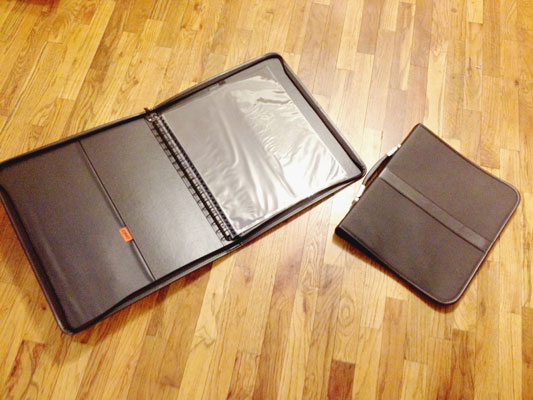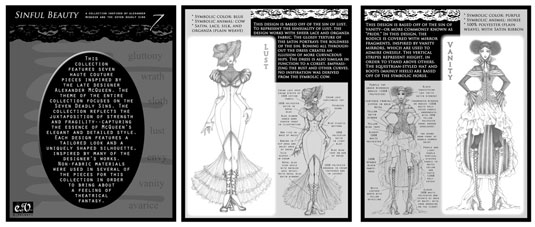Physical portfolios contain the hard copies of your work. Hard copies can include your original sketches or scans of your work printed out and placed in the physical portfolio. (You might want to use scans instead of your originals in your portfolio; that way, if something happens to the copies, you can go back to the original.)
You slip the hard copies inside plastic sleeves that you then place inside a professional-looking portfolio, which you can take with you to interviews or networking events. You can use something as simple as a black zippered case with a handle that holds all your sketches.

Digital portfolios put your work into any kind of digital presentation. A digital portfolio can include pages on a website, a folder from a portfolio-hosting website, a file such as a PDF with multiple pages, or a PowerPoint slideshow.
After you’ve completed the digital file, you can email it to people in another city or country or post it online for others to view. A digital file of your work may start out as a slideshow full of your sketches (these sketches are by Christina Ngo).

The best choice is to have both types of portfolios — physical and digital. That way, you can send your digital portfolio by email or refer potential clients to your website before you meet in person so they can get an idea of your talents. During the meeting, you can talk through your creations as your potential client browses through your traditional portfolio.
Designing a digital portfolio
A digital portfolio simply means one you can access on a computer device, including mobile devices. All fashion illustrators in today’s world need to know how to use the computer to their advantage.Choosing work for your digital portfolio is no different from choosing images for a traditional portfolio. A benefit of putting together a digital portfolio is that you can include more work — but not too much more — if you can’t narrow your choices to 10 or 15 of your best pieces.
Scanning your fashion drawings
Scanning your work isn’t quite as simple as laying a sketch on a scanner and pressing Start. Scanning is a little more complicated than that because you must pay attention to the amount of detail you want the scanner to capture. Resolution and file type are two aspects you need to know when scanning and working with digital images.Resolution is a way of measuring the amount of digital information in a picture. When you scan, you have the option to choose the resolution, sometimes called dots per inch (DPI). Scan your images at 300 DPI. This setting has several advantages: It captures a lot of the detail in the image, the file size isn’t too large, and you can print the picture at a fairly large size before it starts to get blurry.
You also need to pay attention to the file type the scanner creates. Most scanners scan the image as a JPEG (joint photographic experts group), TIFF (tagged image file format), or PDF (portable document format). You can control which type of file you create by checking the software settings before you hit Save. For beginners, it’s best to stay with the JPEG format.
Fixing your fashion images
Digital sketches don’t always have the same look as the physical sketch. Scanning in sketches may not capture the beauty of the drawing; you may need to edit the scan to adjust the colors or erase dust spots. For this, you may need to master an image-editing program such as Adobe Photoshop.Photoshop is the most common editing program in the fashion industry. After you scan your image, Photoshop allows you to play with the colors, draw new lines, add text, and crop and collage images together. It’s a powerful tool that allows endless amounts of creativity.
Posting your digital portfolio to a website
Using a website to host your work is great if you have the smarts about website building or are lucky enough to have an awesome friend who can do it for you! A website costs some money for hosting it (and possibly building it), but think of the website as an investment.It’s great for getting your work out there, and it makes viewing your work easy for potential clients. What’s easier than introducing your work to a potential employer simply by giving them your website address?
If creating a website sounds overwhelming, don’t fret. Many free portfolio-hosting websites are available. Search the internet, and you find many sites where you can sign up and post your files in a portfolio-type setting. These sites give you your own link to send to people so they can go right to your portfolio. Some free portfolio-hosting websites that are user-friendly include the following:
Posting to these sites is as easy as scanning your sketches, saving them as JPEG files, and uploading them on the site. Usually, the websites have little tutorials to walk you through how to post your files. In ten minutes, you can have your files online!If you have a fashion blog, link to your portfolio from your blog instead of posting your portfolio on your blog. If you post your digital portfolio online, be sure to put the web address on your business card.
Creating a fashion slideshow
You can also create a digital portfolio that consists of a slideshow file, which you can email to potential clients. The two most common types of slideshow files are the PDF file and the PPT (PowerPoint) file. Most computers have the programs to run these open-and-read file formats.Save your portfolio in both formats in case the person you’re sending the file to doesn’t have one of the programs to open the file. Marketing yourself includes making things as easy as possible for your clients.
To create a portfolio in either program, use the picture files you created when scanning your images. Place the picture files in the order you want them to be seen in either program.
Both file formats allow you to place files on multiple pages. The viewer can simply click a button to flip through the pages of your portfolio. The order of your pages, the amount of work, and the type of work you include should follow the same guidelines as those for the physical portfolio. Only the presentation format differs.
If you want to add slides with supplemental information to your slideshow, you can, but stay away from animation or sounds because they can come across as unprofessional.

